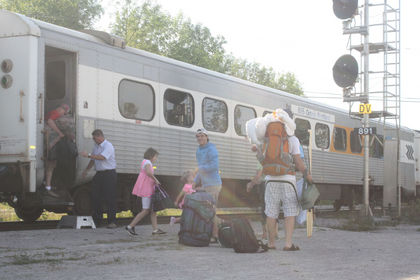From The Toronto Sun:

Around the world there is a quiet revolution brewing. Everywhere except Canada, that is.
It’s based on shared principles and cuts across all political divides by uniting disparate communities through a single, common goal.
No, it’s not a religion, faith or creed.
It wants a return to railways as an efficient way to move people and produce as modern roads and skies become more crowded by the day.
You can find new railways being built in Africa and Asia, Europe and the United States. Some are for fast passenger movement and more and more involve dedicated freight lines.
If this transport revolution is ever to reach critical mass here in Canada, a country that has lost more than 10,000 kilometres of track since 1990 in places as far apart as Vancouver Island and Quebec, it will need to start in the heavily populated province of Ontario.
The Northern & Eastern Ontario Rail Network (NEORN) is a lobby group dedicated to that goal.
It launched a major push Monday to reawaken Canadians to the benefit of rail transport.
Members say concern about rising fuel and road maintenance costs, the need to dramatically reduce carbon emissions and provide the transportation infrastructure necessary for economic development, drives their call for policy makers to return to the values of 100 years ago when steel rails pulled the nation together as one.
“Look back to early last century and Canada was a world leader in rail development,” said Dr. Linda Savory Gordon, Professor Emerita at Algoma University and NEORN member.
“This is a huge country that could only be made to work by binding it together with steel ties. We seem to have lost that vision. Maybe it is time to catch up with the rest of the world and start renewing our rail infrastructure.”
Savory Gordon singles out Ontario as a growing province, rich in population density and major cities, that is counter intuitively closing down rail lines at an unprecedented rate.
As recently as March 2012, the Ontario government announced it was divesting the Ontario Northland Transportation Commission. The Northlander, a six-days-a-week passenger train service connecting Cochrane to Toronto, was discontinued six months later.
Pressure is building to close more lines and switch investment dollars to freeways. This is despite the fact that rail transport is anywhere from 1.9 to 5.5 times more fuel efficient than truck transport and a single train can move as much as 280 trucks.
NEORN claims neglect of rail in Ontario has erected barriers to social and economic opportunity while delivering a substantial over-investment of taxes into road repair and expansion. It points to a Leger poll taken in 2009 that showed significant public support (87%) for government investment in rail.
“We live in an era of concern about rising fuel and road maintenance costs,” Savory Gordon said, “and we have the desperate need to dramatically reduce carbon emissions.
“Rail addresses those concerns. It is a real alternative to more public money being sunk into roads and there is ample evidence that planners across the globe believe in that.”
The South African province of Gauteng is a case in point.
It hosts two major cities in Johannesburg and Pretoria and with an almost identical population base and geographic spread as Ontario, has launched a transport master plan which aims to make rail the ‘backbone’ of the region’s public transport network.
Gauteng has released a 25-year plan for a more integrated approach to transport planning, ensuring that residential and commercial development takes place along the province’s main passenger rail corridors.
It also stipulates general aims to modernize all existing rail networks and set future performance targets.
The report states that: “Due to under-investment during the past number of decades, passenger rail transport is not playing its appropriate role in Gauteng.
“There are indications that metropolitan transport planners do not consider the service levels on the rail transport system as sufficiently reliable to form the backbone of an integrated public transport network.”
If that sounds familiar, then replace the word ‘Guateng” with `Canada’ and you see why NEORN wants Canada to start thinking creatively and use steel rails as a starting point.
Source: http://www.torontosun.com/2013/08/24/group-pushes-for-railway-expansion-in-canada
